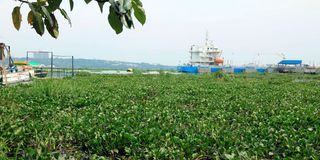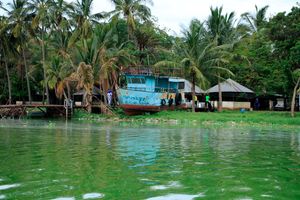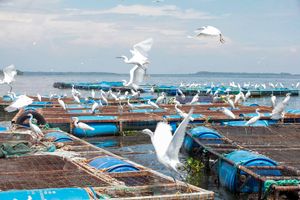Livelihoods hit as water hyacinth returns to Lake Victoria

Water hyacinth covers a section of Lake Victoria on January 18. The invasive weed has reared its ugly head again,interfering with the scenic view of the lake, fishing activities, movement and excursion.
What you need to know:
- The aggressive weed appears when certain conditions favour it’s growth. For example high nutrient loads in the lake.
- Currently, the weed has covered 1,000 hectares of Nyakach and Winam Gulf in Kisumu County, Asembo Bay in Siaya County and Kendu Bay in Homa Bay County.
The resurgence of water hyacinth in Lake Victoria has started to take a toll on different sectors that depend on the lake for their livelihoods, and stakeholders are already feeling its effects.
In some parts, hoteliers have resolved to hiring labourers to manually uproot the hyacinth, which interferes with the scenic view of the lake, movement and excursion.
The aggressive weed appears when certain conditions favour it’s growth. For example high nutrient loads in the lake.
Currently, the weed has covered 1,000 hectares of Nyakach and Winam Gulf in Kisumu County, Asembo Bay in Siaya County and Kendu Bay in Homa Bay County.
Kenya Marine Fisheries and Research Institute Director of Freshwater System Research, Dr Christopher Aura, said: “From our satellite images, the water hyacinth has covered most of the bays in the lake due to the nature of water stagnating in those areas.
He said the population of the invasive weed is bound to increase due to favourable climatic conditions, which boost its growth.
“The windy weather is pushing the weed to the shores. Currently the water hyacinth is in the cycle of flowering and seed production. The last time the weed surfaced was about three years ago,” said Dr Aura.
Homa Bay County Fisheries Director George Okoth said there have been several attempts to get rid of the hyacinth. However, most of the interventions have not fully eradicated the weed.
The interventions include manual removal, use of machines to cut the aquatic weed as well as a biological system where a beetle was introduced in the lake to feed on the plant.
According to Mr Okoth, the biological system was the best.
“There was a significant reduction in the size of areas on the water surface that the weed covered after the beetle was introduced,” he said.
The beetle was introduced by the Kenya Agricultural and Livestock Research Organization.
In Homa Bay County, fishermen are staring at a bleak future due the impact the hyacinth has had on their fishing activities. Fishermen normally have difficulties accessing the lake when the aquatic weed appears.
Kendu Bay beach management unit chairman Ibrahim Kasera said fishermen have been recording a decline in daily catch since the weed started reappearing. On a good day the wild fish catch could go up to 1,000 kg but it has reduced drastically. He fears that this might negatively affect fishermen who depend on fishing as a source of livelihood.
“Our daily catch has been reduced to less than 200kg, which is a threat to food security. Most fishermen cannot go to the lake when it is covered with hyacinth,” he said.
According to Mr Kasera, there is an increase in the population of lung and catfish but Tilapia and Nile perch catch has reduced. He noted that the weed also creates a hide-out for crocodiles, snakes and dangerous wild animals that could harm fishermen. “Increased pollution in the lake makes the plant thrive. This is having a ripple effect on the entire fishing cycle,” Mr Kasera said.
Normally, hyacinth covers the water surface like a blanket, making it difficult for fishermen to steer their boats as it tangles fish propellers. The plant floats on water and moves depending on wind direction.
Mr Kasera said the plant shifts from one location to another depending on the weather.
“As it moves, some fishermen get trapped in between the plants. There is a risk of them being trapped in the water for many hours,” the BMU official said.
Some fishermen from Kendu Bay have begun migrating to new fishing grounds as they try to escape the wrath of water hyacinth.
Mr Kasera called for a lasting solution in controlling the weed.
“The lake has employed thousands of people, helping them to put food on the table. Any reduction in the number of fish caught in the lake makes life difficult for so many people,” Mr Kasera said.
The Lake Basin Development Authority in collaboration with Kenya Shipyard Limited and Kenya Ports Authority have started dredging to combat the rapid spread of this invasive weed. Dredging is the process of removing sediments and debris to restore depth in water bodies.
It helps in restoring the aquatic ecosystem for plants, fish and wildlife. It also removes unwanted nutrients from the sediment and water column, improving water quality. It prevents the development of harmful algal blooms, which are toxic to humans, fish and wildlife. It also increases waterbody volume and depth.
[email protected], [email protected]@ke.nationmedia.com






